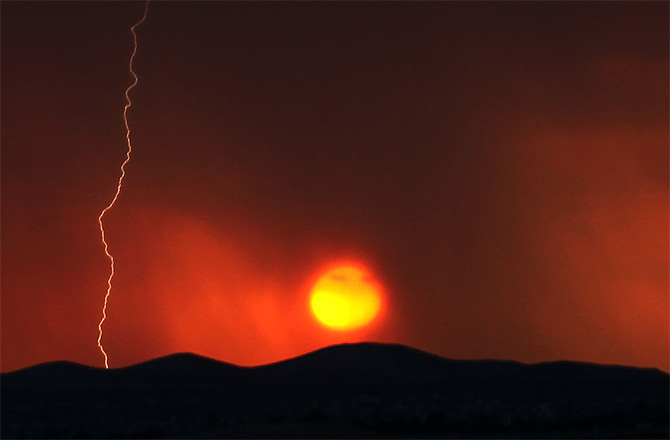
© CorbisThe sun is obscured by thick cloud during a thunderstorm in California in 2009.
It's no secret that the sun has wide ranging impacts on our planet - it is, after all, the primary energy source for our biosphere. But when it comes to how the sun impacts climate variations and weather phenomena, scientists can have a hard job teasing out the sun-Earth connections.
One connection, however, is no secret. When the solar wind impacts the Earth's magnetosphere - the global magnetic field that deflects the sun's ionizing particles to the poles - high latitudes can be treated to a beautiful light display called the aurora. But can the solar wind have other, more "everyday" impacts on our atmosphere? Yes, says a new study published today (May 14) in the journal
Environmental Research Letters.
University of Reading scientists have seen, for the first time, that the ionizing particles in the solar wind streams may influence thunderstorm activity levels. This offers compelling evidence that there is a fascinating link between space weather and the triggering of lightning.
"Our main result is that we have found evidence that high-speed solar wind streams can increase lightning rates," said lead researcher Chris Scott. "This may be an actual increase in lightning or an increase in the magnitude of lightning, lifting it above the detection threshold of measurement instruments.
"Cosmic rays, tiny particles from across the Universe accelerated to close to the speed of light by exploding stars, have been thought to play a part in thundery weather down on Earth, but our work provides new evidence that similar, if lower energy, particles created by our own sun also affect lightning."
Scott's team focused on the central England region and studied thunderstorm data from 2000 to 2005 obtained from the UK Met Office's lighting detection system. Then they took data from NASA's Advanced Composition Explorer (ACE) spacecraft, which is embedded in the solar wind in a direct line between us and the sun. Any solar wind streams that hit ACE continue "downstream" to Earth.
The sun produces solar wind streams of different velocities, so as the sun rotates, fast solar wind steams "catch up" with the slow wind streams. The region where the streams interact can increase the density of energetic solar wind particles. The Earth will pass through these interaction regions and we will often detect an uptick in space weather.
As the sun rotates every 27 days, high-speed solar wind streams regularly and predictably sweep past the Earth. After accumulating the five years of ACE and Met Office lighting data, the researchers found that, on average, there were 422 lightning strikes over the following 40 days after the Earth passed through one of these dense streams. Over the 40 days prior, there were an average of 321 lightning strikes. The lightning strike peak rate occurred 12-18 days after solar wind stream arrival.
There does seem to be a statistically significant enhancement of lightning activity relative to space weather conditions, but it is worth emphasizing that this study only focused on a small area in central England, so it would be interesting to see if a similar pattern is detected elsewhere around the globe. But if this is a real phenomenon and solar wind particles are triggering lightning bolts, what mechanism could be driving it?
The researchers suggest that as the Earth passes through the high-speed, dense solar wind streams, ionizing solar wind particles have enough energy to penetrate deep into the Earth's magnetosphere, interacting with our atmosphere.
"We propose that these particles, while not having sufficient energies to reach the ground and be detected there, nevertheless electrify the atmosphere as they collide with it, altering the electrical properties of the air and thus influencing the rate or intensity at which lightning occurs," said Scott.
This sounds reasonable as it is well known that during solar storms, when energetic solar particles interact with our atmosphere during auroral activity, huge global currents are induced through the Earth's atmosphere. A similar modification of the electric field in the lower atmosphere may also be occurring, potentially enhancing weather systems and triggering electrical storms.
"In increasing our understanding of weather on Earth we are learning more about its important links with space weather. Bringing the topics of Earth Weather and Space Weather ever closer requires more collaborations between atmospheric and space scientists, in which the University of Reading is already leading the way," added Giles Harrison, head of Reading's Department of Meteorology.
Just stop supressing available data & let uncorrupted scientists with long-term interdisciplinary approach to be heard.